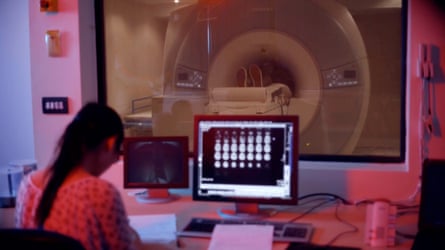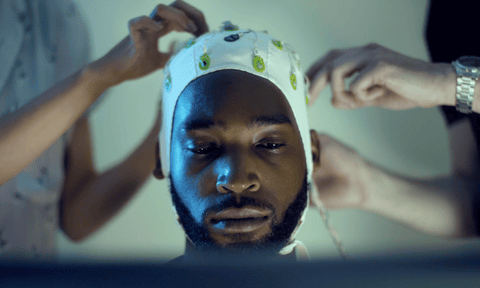‘Can science get us to a point where there’s a formula to drive a specific emotion?” asks Tinie Tempah as he puts on an EEG (electroencephalogram) hat, which looks like a weird swimming cap with wires sticking out of it.
For Professor Slawomir Nasuto and Dr Ian Daly, this is the “holy grail” at the heart of a five-year project. They’re hoping to harness the emotional power of music for therapeutic uses – “to create a system which eventually will be able to help people with depression and different forms of emotional disorders associated with neurological disorders.”
“Music evokes emotion,” says Tinie. “Music can bring a crowd of 100,000 people from all different races, religions, sexualities all together – there’s not many mediums that can do that.”
Nasuto is the director of Reading University’s Brain Embodiment Laboratory, within the Biomedical Engineering Section of the School of Biological Sciences, who use everything from robotics to tissue culture labs to research the relationships between body, mind and environment. With Daly he’s been working on the Brain Computer Music Interface for Monitoring and Inducing Affective States (BCMI-MIdAS), a joint project with a team at the University of Plymouth lead by Professor Eduardo Miranda. Normally the participants they work with are undergraduate students. But today their subject is Brit and Mobo award-winning rapper Tinie Tempah, a musician who’s more used to scanning lyric sheets than having his brain scanned in a university lab.
For the experiment, they get subjects like Tinie to listen to music under laboratory conditions: hooked up to an EEG while having their brains scanned from the inside of an fMRI (functional Magnetic Resonance Imaging) machine – which bears some resemblance to a giant sci-fi donut.

There’s always been a strong connection between music and emotion. We listen to sad songs when we’re down, put upbeat music on to dance to when we’re happy. It amplifies our emotions, punctuates the big moments in life, makes the everyday a bit more fun: we sing at weddings, we play music at funerals, commute with headphones on, lose ourselves in festival gigs.
From their different perspectives, the scientists and musician both agree on music’s emotional power.
Nasuto argues that music has always had “a very strong emotional affect on humans. There is a very primeval link between us and music – it has been with us for a very long time, probably the beginning of human culture.”
In scientific terms, Nasuto describes music as “a very powerful type of stimulation which can evoke emotional responses”, and it’s this effect that has lead them to study how it works on the brain. If you can see what’s happening inside someone’s brain when they are listening to a happy or a sad song, then it’s a starting point to understanding how music affects human beings.
Of course, then you have to find a way to define everyday terms like “happy” or “sad” in a way that makes sense in a laboratory; in other words, to find a way to quantify and measure emotions.

For their study, the team at Reading use a “valence arousal circumplex model” – a graph which “maps all of the complexity of human emotions onto two axes.” The valence axis, Daly explains, shows “how pleasant or unpleasant an experience is”, while the arousal axis measures “how exciting or boring an experience is.” In this way it’s possible to plot an emotional response between the two. For example, “fear is an emotion which is highly arousing and very low valence, both exciting and unpleasant” says Daly, whereas “calm” would be unarousing and low valence – a pleasant but not very exciting experience.
By combining data sets, a fuller picture of what’s happening when we experience emotions emerges; we can see what areas of the brain are being stimulated when our brains are listening to music, and how much activity there is. In other words, what your brain looks like “on music”.
In their studies, the scientists play their subjects a combination of classical and “synthetic music” – not electroclash or EDM, but music generated by a computer algorithm developed by Professor Eduardo Miranda, Dr Alexis Kirke and Dr Duncan Williams at Plymouth University that helps to create a controlled test (it’s the abstract music you can hear playing in the interactive here).
The idea, says Nasuto, is to create music that’s as near as possible to laboratory conditions; Plymouth’s algorithmic music generation “enables us to provide as simple as possible stimulus by reducing the complexity, but it also gives us a much stronger control on manipulating individual features.”
Dr Daly explains: “technically the synthetic music is music, but it’s not really the most exciting stuff to listen to, so we play classical music to all our participants to get a bit more of an in-depth look at how people respond to different types of music.
“Your emotional response to music changes for the second or third hearing – the first time you hear a piece of music you react differently. So if we can use generated music you can guarantee that they’ve never heard that piece of music before. Whereas if we use real music, whether it’s pop music or classical music, it’s quite likely that the participant may have heard that piece of music before.”
Nasuto continues, “music itself is a very complex acoustic signal or stimulus – it interacts with us on many different dimensions. It is an acoustic stimulus like anything you hear, but also it interacts with us on a cognitive level because we can appreciate the structure of the music, the patterning of the melody and so on.” If they used normal music for the whole study it would be “very difficult to isolate and pinpoint the causes of particular emotional changes in the subject,” he says.
According to Daly, the test shows that “we’re able to identify which regions of Tinie’s brain are responding to music-induced emotion.” As for bringing the worlds of science and music together to share their experience of emotion, perhaps the scientists have learned as much from Tinie as he has from the experiment.
“It was interesting to listen to Tinie’s explanation that when he comes to compose music it has to feel right for him – there is an element of a very intuitive, qualitative assessment which he seems to be using which refers to his personal feelings about how the music feels to him, a kind of body resonance with the music,” says Nasuto. “It’s not an assessment that is very explicitly cognitive – although perhaps there are some cognitive processes going on when he actually decides how to develop the piece of music. But whether he’s satisfied with it or not goes back to this basic emotional response.”
For Tinie, his takeaway from the experience is more straightforward. “Whether you’re in a festival or at your house, music can make you come out of yourself, be like an ultimate version of yourself. It’s interesting to know what affects my mood, what makes me happy. At the end of the day music is always going to be an emotional thing for me, it’s a feeling.”
